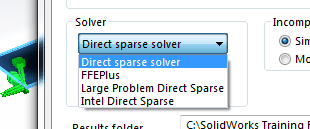SOLIDWORKS Simulation 2015 – FEA Solvers
A few years ago I wrote an article regarding Solver Selection for SOLIDWORKS Simulation. At that time we had two solver choices – FFEPlus and Direct Sparse. Last year, SOLIDWORKS Simulation 2014 introduced the Large Problem Direct Sparse Solver. Now with the introduction of SOLIDWORKS Simulation 2015 there are improvements to the FFEPlus solver as well as a new solver, the Intel Direct Sparse Solver.

Per the SOLIDWORKS 2015 What’s New documentation, the FFEPlus solver has improvements to connector formulation and contacts. The new Intel Direct Sparse solver is available for static, thermal, frequency, linear dynamic and nonlinear study types. Like you, I want to see how these changes affect the solution times for my finite element studies. Faster solutions are always welcome!
Using SOLIDWORKS Simulation 2014 and 2015 I solved several different study types to compare solver performance. The benchmark files I used were a combination of SOLIDWORKS Simulation Training files and customer files from technical support cases. All of these files were originally in SOLIDWORKS 2014 format. For testing these models in 2015, I used Pack-and-Go to create a version to update. Once I opened the files in 2015, I forced the model to rebuild then saved them to the 2015 file format. In Simulation, I updated the components for the FEA study and re-meshed the finite element model. Finally, after the solution completed, I recorded the solve time for each study type and solver combination using the Solver Messages information. The results of my testing can be seen in the included picture.

For the improved FFEPlus solver in 2015, I calculated how much faster a study ran compared to the 2014 solution. Half of the study types investigated had improved solution times while the other half were slightly slower. Until I can investigate several more finite element models, I’ll consider this a draw. As for the new Intel Direct Sparse solver, the solve times calculated were quite impressive! The percentages shown are how much faster the Intel Direct Sparse solver was compared to either the (original) Direct Sparse or the Large Problem Direct Sparse solver. In all six studies, the Intel Direct Sparse solver performed better than the other Sparse solvers. The Intel solver really shined for Steady State Thermal (62%), Linear Buckling (46%) and Linear Static (31%) studies for the models I investigated compared to the Direct Sparse solver. To be fair, the Large Problem Direct Sparse solver is intended for Finite Element Models with greater than 1.5 million degrees of freedom, which I did not investigate during this testing.
With the majority of our work, what we care about most is getting the job done. With regards to Finite Element Analysis, this means getting the study to calculate to completion. If that study can be solved faster by choosing one solver over another, all the better! For SOLIDWORKS Simulation 2015, I think I’ve identified my default solver of choice – the Intel Direct Sparse solver. Now go make your products better – faster – with SOLIDWORKS Simulation!

 Blog
Blog